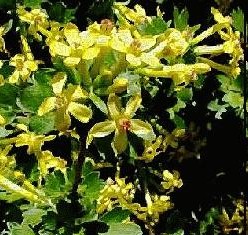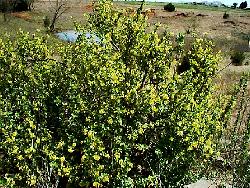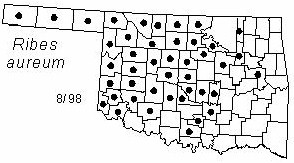

Shrub to 3 m (9 ft) tall. Crown irregular. Bark gray to red-brown. Twigs red-brown, glabrous, puberulent when young. Leaves alternate or fascicled, simple, margins orbiculate or cuneate-ovate with 3-5 lobes, glabrous, may be puberulent beneath, light green and glossy, 1-2.5 cm (0.4-1 in) long and wide; cuneate to subcordate at base, entire or toothed near the apex. Leaves are light green and glossy. Flowers in short racemes of 5-10, with the strong fragrance of cloves; sepals 5, oblong-obovate, calyx salverform; petals 5, reddish, inserted at the top of the calyx tube; ovary 1, erect, stamens 5. Flowers appear April through June. Fruit a berry, 8-10 mm (0.3-0.4 in) diameter, globose to ellipsoid, black, with numerous seeds, matures June to August.
Distribution: Oklahoma, Arkansas, and Texas, north Minnesota and South Dakota, west to the Rocky Mountains. Common in central and western Oklahoma.
Habitat: sandy habitats, or rocky slopes and ravines.
Comment: The genus name, Ribes, is derived from the Danish word "ribs" for the red currant; the species name, aureum, refers to the golden-yellow color of the flowers.
Field identification: buffalo currant is the only spineless member of the genus Ribes in Oklahoma
Wildlife benefit: The fruit of buffalo currant is eaten by several wildlife species and birds.
Horticulture: Buffalo currant first entered cultivation in 1812. The plant is easily cultivated from seed or cuttings. It is widely planted for the fragrant flowers and fruits. The plant was exported from North America to Europe as rootstock, where it has escaped from cultivation and can be found growing in sandy soils.
Food uses: The fruits are made into jams and jellies.
Medicinal uses: The Kiowa believed that snakes were afraid of the currant bush and used it as a snakebite remedy.
Economic uses: some tribes used the fruits to color clay pots.
NWI status: FAC-, FACW.
Distribution in Oklahoma: 
BACK
NEXT
RETURN TO INDEX
Last update: 9/17/99
 Go to Oklahoma Biological Survey Home Page
Go to Oklahoma Biological Survey Home Page
 Disclaimer
Disclaimer